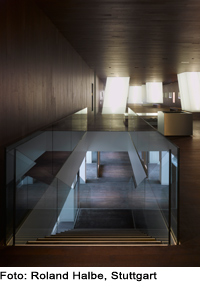Archaeological Museum in Vitoria

Vitoria, in the province of Álava, is the capital of the Basque community in Spain. Erected on a small site within the densely built-up old city centre, the new complex for the archaeological museum adjoins the rehabilitated Bendaña Palace, which dates from the 16th century. The two buildings are linked by a common courtyard. The new museum presents a virtually closed front to the street: clad with ribbed bronze sheeting, the facade is interrupted by only a few openings. The building was designed rather like an outsize jewellery casket to form a safe housing for the exhibits. The deep cedar-clad reveals give some indication of the double-skin external wall construction, in which showcases and the technical services for the museum are integrated. Here, the exhibits are displayed like objects in a shop window or showcase.
Temporary exhibitions are held on the ground floor. From this level, visitors ascend via a cascading staircase to the permanent displays on the upper levels. There, the exhibition spaces are free of intermediate columns, and the wood finish to all surfaces is almost black. The top storeys are penetrated by five raking light shafts. These elements are in a steel skeleton-frame construction clad with translucent glass and are topped by lanterns that extend above roof level. The shafts conduct daylight into the depth of the museum. Fluorescent tubes integrated within them ensure a pleasing night-time lighting atmosphere.
